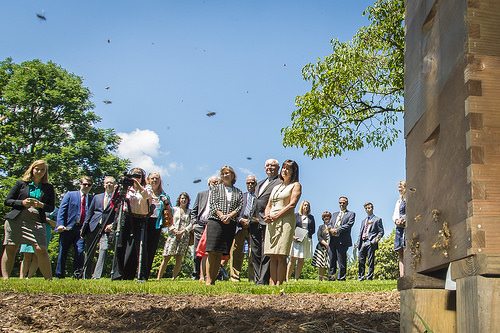Ask Public to Help Boost Pollinator Population

Secretary and Mrs. Perdue joined Second Lady Karen Pence to unveil a new beehive on the grounds of the Vice President’s residence.
Second Lady Karen Pence and Agriculture Secretary Sonny Perdue today unveiled a newly-installed beehive on the grounds of the Vice President’s residence, drawing attention to the plight of pollinators whose numbers are in decline. Together, the two urged Americans to do their own part to help reverse the population trend among the creatures, which are essential to producing much of the nation’s food.
“All types of pollinators, such as bees, butterflies, birds, and bats, are critical to providing our nation’s food, fiber, fuel, and medicine,” Mrs. Pence said. “However, our beekeepers have been losing colonies for many years. This presents a serious challenge to our ability to produce many of the agricultural products that we enjoy today. The bees at the Vice President’s Residence will provide an added bonus to the vegetable and flower gardens by making them well pollinated and taste even better at harvest.”
Perdue released a proclamation he has signed declaring June 19-25, 2017 as “National Pollinator Week” (Proclamation can be viewed online at https://www.usda.gov/sites/default/files/documents/national-pollinator-week-secretary-proclamation.pdf (PDF, 97.5 KB)). Perdue noted that the U.S. Department of Agriculture (USDA) and the Environmental Protection Agency led efforts to create a National Pollinator Health Strategy. The two agencies are working with a number of other federal departments to implement that strategy, which includes significant USDA research.
“Most farmers and consumers have no better friends and few harder workers than the honey bee, as more than one-third of all U.S. crop production requires insect pollination,” Perdue said. “But our honeybee population has been losing ground at an alarming rate. The problem represents a diverse mix of challenges requiring a wide range of solutions. And at USDA we are leading the way in research to help out our pollinator friends.”
Honeybees are the nation’s primary pollinators, adding at least $15 billion a year in value to about 90 crops by increasing yields and helping to ensure superior quality harvests. Those crops include nuts, fruits, berries, and vegetables, which add color, taste, and texture to our diet.
The number of honeybee hives in the U.S. has declined from 6 million during the 1940s to only about 2.5 million today. Those losses have been attributed to a number of factors, ranging from a syndrome known as “colony collapse disorder” to stress caused by factors such as parasites and pests, transportation of bees, sub-lethal exposure to pesticides, and poor nutrition.
Mrs. Pence and Secretary Perdue pointed out that a lack of supportive habitat near hives also contributes to the declines. Even if people don’t set up their own hives, they can help by planting bee-friendly flowers and flowering herbs in their yards and gardens. Honeybees particularly love wildflowers, lilacs, poppies and Black-eyed Susans, as well as herbs and vegetables like mint, sage, squash, tomatoes, oregano, and rosemary. In addition, bees get thirsty, and that placing birdbaths and small basins of water could help relieve their thirst.
Mrs. Pence installed a beehive in the Indiana governor’s residence in 2014, when Vice President Mike Pence served as the state’s governor. She said more than 80 percent of the land in Indiana is dedicated to agriculture, and its crops are very dependent upon pollinators.
The hive unveiled today is located on the grounds of the Vice President’s Residence. It is a triple-deep “Langstroth” beehive that holds traditional frames and was obtained from Eco Honeybees of Falls Church, VA. The hive contains almost 20,000 bees and continues to grow.










